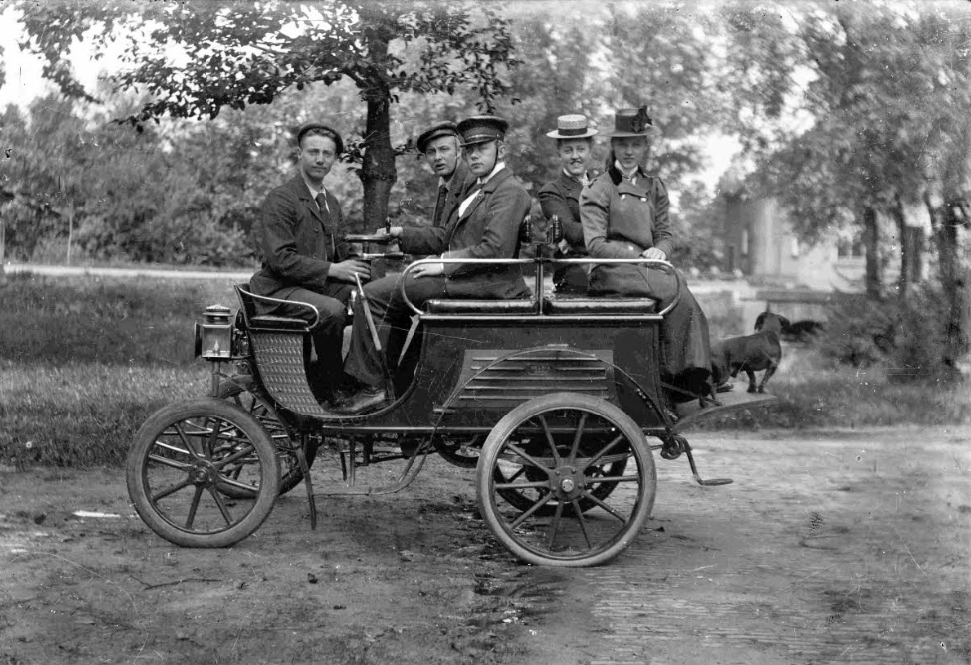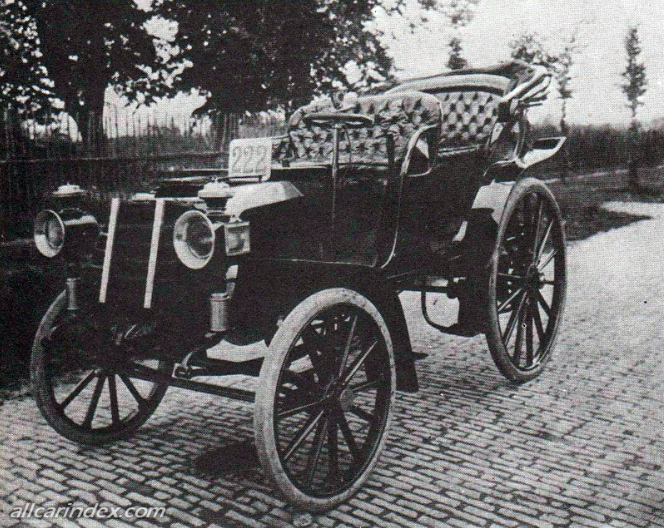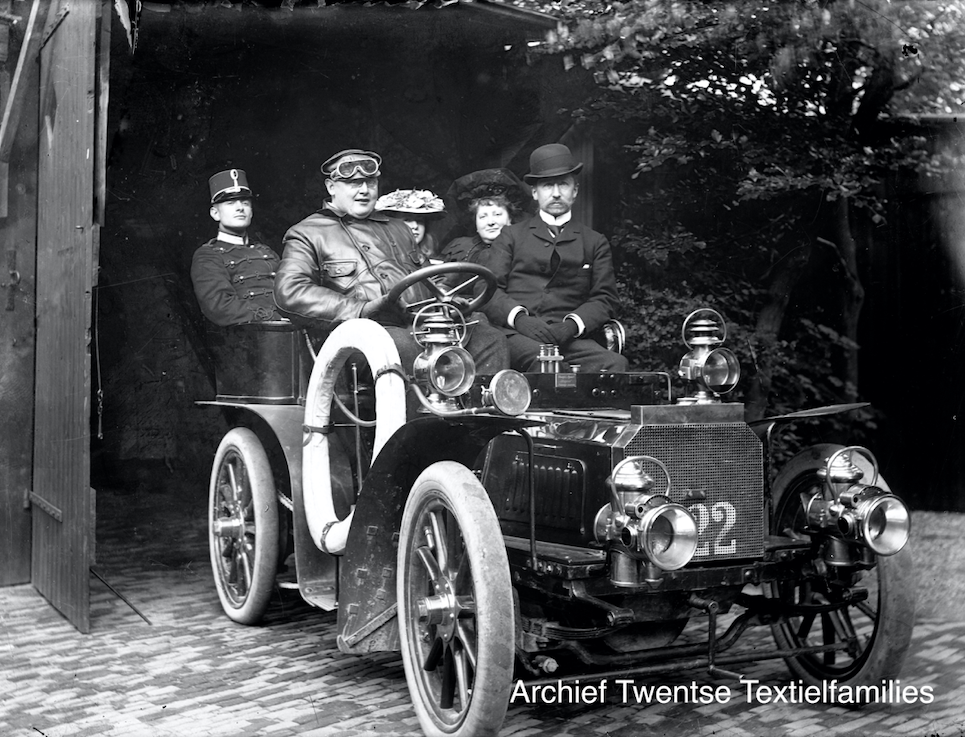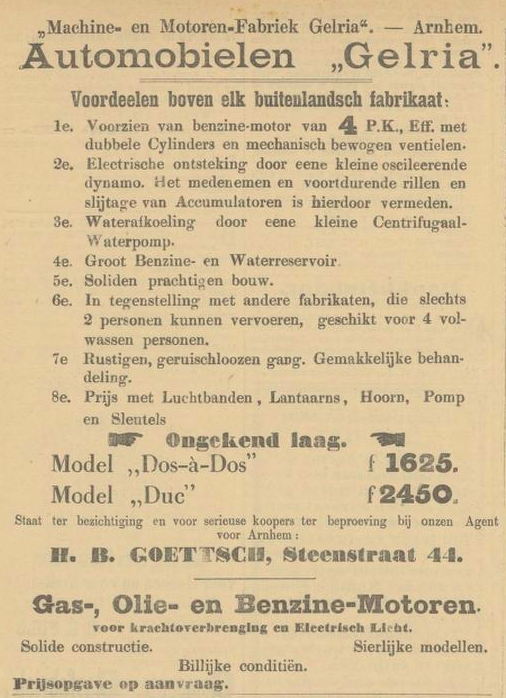De autopioniers Jannink uit Goor
De vraag wie de eerste automobilist van het land was, valt niet met zekerheid te beantwoorden. Aanvankelijk werd gedacht dat fotograaf Zimmermans uit Arnhem deze titel verdiende omdat hij in 1896 een Benz Victoria bestuurde, dat de eerste benzineauto op vier wielen was. Echter, in 1996 onthulde de journalist Marius van Melle dat al eind 1895 Jos Bogaers, een jonge textielfabrikant uit Noord-Brabant, in een auto reed. Er kunnen echter meer vroege automobilisten zijn geweest, daar een landelijk kentekenregister pas in 1898 werd ingevoerd. In Enschede was de autopionier in ieder geval W.H. ‘Helmich’ van Heek (1866-1929), die sinds 1899 rondreed in een Benz Comfortable met kenteken ’70’. In Goor onderscheidde G.J. ‘Jan’ Jannink (1844-1912) zich als eerste automobilist met kenteken ‘222’, nadat hij in 1900 twee voertuigen kocht van de Arnhemse machinefabriek Gelria. Op de foto zien we Jan’s oudste zoon Nic achter het stuur, naast compagnon Hermann Reerink, met bolhoed. Beiden waren firmanten der textielfirma Arntzenius, Jannink & Co, dat destijds bekend stond om haar nettenweverij in Goor en bontweverij in Wierden.
Het is goed mogelijk dat Jan Jannink in maart 1900 geïnspireerd raakte tijdens een bezoek aan een tentoonstelling in het inmiddels verdwenen Paleis voor Volksvlijt in Amsterdam, waar onder meer automobielen werden gepresenteerd. Deze populaire tentoonstelling bood bezoekers de kans om kennis te maken met de nieuwste modellen van bekende merken zoals Peugot en Daimler, alsmede creaties van de inmiddels verdwenen Nederlandse machinefabrieken Trompenburg en Gelria. Een journalist prees de ‘duc’ van Gelria als het ‘allermooiste karretje van de gehele tentoonstelling’. Dit specifieke model, dat ruimte bood aan vier volwassenen, had een vraagprijs van 2.450 gulden – destijds een groot bedrag. Gelria bood tevens een voordeliger model aan, de ‘Dos-à-Dos’, geprijsd op 1.625 gulden. In advertenties benadrukte de firma Gelria de ‘voordeelen boven elk buitenlandsch fabrikaat’. Toch moest Gelria in 1906 haar fabrieksdeuren sluiten.
De technologische ontwikkelingen van de automobiel volgden elkaar in rap tempo op, waardoor auto’s snel achterhaald bleken. Dit leidde ertoe dat zowel Jan Jannink als Helmich van Heek hun voertuigen binnen enkele jaren inwisselden voor nieuwere modellen. Aanvankelijk bood het bezit van een automobiel weinig praktische voordelen, maar was het vooral een hobby voor de welgestelden die de technologische ontwikkelingen graag op de voet volgden. Ondanks de vele technische problemen die de auto’s in de beginperiode hadden, genoten de Janninks uit Goor optimaal van hun nieuwe aanwinsten. Een neef uit Enschede haalde op gevorderde leeftijd herinneringen op aan ‘oom Jans hobby van motoren’, die regelmatig te maken kreeg met koelingsproblemen bij zijn Gelria-auto’s. De blijdschap was groot wanneer de auto naar behoren werkte, wat steevast gevierd werd met de uitdrukking: ‘Hij doet het!’ Vooral lange afstanden vormden een uitdaging voor de Gelria-automobielen, waarbij het regelmatig noodzakelijk was om een pauze in te lassen om de motor te laten afkoelen. In situaties waarbij de auto onderweg uitviel, was er gelukkig altijd nog een betrouwbaar paard te vinden dat de auto naar huis kon slepen..

Een brief van Mietje Jannink-Ledeboer, de vrouw van Jan, biedt een levendig beeld van het vroege automobilisme:
‘Gistermiddag heeft de biel ons toch weer braaf in huis gebracht. We waren om ¼ na 3 weer thuis. Eerst liep hij wat langzaam, maar later was hij heel vlug zoodat we zelf Spanjaard – die ons voor reed en ons in de stof zette – maar voorbij streken tot mijne groote voldoening.’

De foto dateert vermoedelijk uit de periode 1902-1906. Het specifieke automodel is nog niet met zekerheid vastgesteld, maar zal vermoedelijk niet een van de twee Gelria-auto’s uit 1900 zijn. De kans bestaat dat het hier om een Spijker gaat, een auto dat door de familie Jannink in 1906 werd verkocht aan Bart Wiegerinck in Goor, die het vervolgens inzette voor zijn eerste taxiritten. Het sleutelen aan de wagens wakkerde bij de drie zonen van Jan en Mietje een passie voor automobielen en motoren aan. Nic, te zien achter het stuur, diende vele jaren als voorzitter van de Koninklijke Nederlandsche Motorrijders Vereeniging, terwijl zijn broer Hens lang als commissaris betrokken was bij de Koninklijke Nederlandsche Automobiel Club. Ook hun jongste broer Engbert, die arts was in Utrecht, was mede-oprichter van een taxibedrijf in Utrecht.
De snelle jongens uit Goor stonden soms in de schijnwerpers van kritiek. In 1910, toen Hens Jannink directeur was van een textielfabriek in Leeds, kocht hij voor zichzelf een auto. Een Enschedese neef schreef daarover vervolgens aan zijn Engelse verloofde: ‘I am afraid money & other things spoil many of my acquaintances lives’. De verloofde bespeurde enige jaloezie, wat door hem een week later met klem werd ontkracht:
‘Don’t think for a moment I am jealous of their prosperity, you know sufficiently how my ideas are in that way. Don’t you?! (…) Someday we have a motorcar if we are succesful! But I think we might just as well leave this to future and see what turns up.’
- In de beginjaren van de automobiel was het rijden een kunst en deed de eigenaar dat graag zelf. In de loop der jaren werd het meer gebruikelijk om zich te laten rijden door een chauffeur, die tevens de taak had om de technische staat van de auto in de gaten te houden en ervoor te zorgen dat de wagen er altijd pico bello uitzag. In het geval van Hens Jannink (1881-1959) was dit sinds begin 1913 de heer Gerrit Hendrik Legtenberg, die ter gelegenheid van zijn 40-jarig jubileum de bronzen eremedaille verbonden aan de huisorde van Oranje-Nassau ontving. Op filmbeelden van de familie Jannink uit 1930 is de heer Legtenberg aan het werk te zien. Hij haalt mevrouw Jannink-ter Horst (Ies) en een grote kinderschaar op bij Villa Scherpenzeel in Goor en zet ze af bij hun grootmoeder Mietje Jannink-Ledeboer, die in de inmiddels verdwenen villa aan het spoor woonde. Later volgt ook mevrouw Jannink-de Ridder (Elly) met haar chauffeur, die iets verder op aan de Diepenheimseweg woonde in Villa Kedingen. Het fragment begint bij 13:14:03.
- Wilt u meer weten over de Gelria-automobielen, leest u dan vooral het artikel van de heer Rutger Booy op conam.info. Op die website kunt u ook meer informatie vinden over oude kentekenregistratie e.d.
- Archief Twentse Textielfamilies, onder meer inventarisnummers 176, 213, 272 en 3992. Overige bronnen: krantendatabase delpher en conam.info
ENGLISH
“The Automotive Pioneers: The Jannink Family of Goor”
The question of who was the first motorist in the country cannot be answered with certainty. Initially, it was thought that photographer Zimmermans from Arnhem deserved this title because he drove a Benz Victoria in 1896, which was the first four-wheeled gasoline car. However, in 1996, journalist Marius van Melle revealed that as early as the end of 1895, Jos Bogaers, a young textile manufacturer from North Brabant, was driving a car. There may have been other early motorists as well, as a national license plate registry was only introduced in 1898. In Enschede, the automotive pioneer was W.H. ‘Helmich’ van Heek (1866-1929), who drove around in a Benz Comfortable with license plate ‘70’ from 1899 onwards. In Goor, G.J. ‘Jan’ Jannink (1844-1912) distinguished himself as the first motorist with license plate ‘222’, after he bought two vehicles from the Arnhem machine factory Gelria in 1900. In the photo, we see Jan’s eldest son Nic behind the wheel, alongside his partner Hermann Reerink, wearing a bowler hat. Both were partners in the textile firm Arntzenius, Jannink & Co, which was known at the time for its net weaving in Goor and fur weaving in Wierden.
It is quite possible that Jan Jannink was inspired in March 1900 during a visit to an exhibition at the now-defunct Palace of Industry in Amsterdam, where automobiles were among the exhibits. This popular exhibition offered visitors the chance to get acquainted with the latest models from well-known brands such as Peugeot and Daimler, as well as creations from the now-defunct Dutch machine factories Trompenburg and Gelria. A journalist praised the Gelria ‘duc’ as the ‘most beautiful carriage of the entire exhibition.’ This particular model, which could accommodate four adults, had an asking price of 2,450 guilders—a significant sum at the time. Gelria also offered a more affordable model, the ‘Dos-à-Dos,’ priced at 1,625 guilders. In advertisements, the Gelria firm emphasized the ‘advantages over any foreign-made product.’ Nonetheless, Gelria had to close its factory doors in 1906.
Technological developments in the automobile followed each other rapidly, causing cars to quickly become outdated. This led both Jan Jannink and Helmich van Heek to trade in their vehicles for newer models within a few years. Initially, owning an automobile offered few practical advantages and was primarily a hobby for the wealthy who liked to keep up with technological developments. Despite the many technical problems that cars had in the early period, the Janninks of Goor thoroughly enjoyed their new acquisitions. A cousin from Enschede recalled in his later years ‘Uncle Jan’s hobby of motors,’ which frequently suffered from cooling problems with his Gelria cars. There was great joy when the car worked properly, which was always celebrated with the expression: ‘It’s working!’ Long distances were particularly challenging for the Gelria automobiles, often requiring a pause to allow the engine to cool down. In cases where the car broke down on the way, there was fortunately always a reliable horse available to tow the car home.
A letter from Mietje Jannink-Ledeboer, Jan’s wife, provides a vivid picture of early automobilism:

‘Yesterday afternoon the carriage brought us home again quite well. We were home by 3:15. At first, it ran a bit slowly, but later it was very fast so that we even passed Spanjaard—who was driving ahead of us and covered us in dust—to my great satisfaction.’

The photo likely dates from the period 1902-1906. The specific car model has not yet been definitively identified, but it is unlikely to be one of the two Gelria cars from 1900. There is a chance that this is a Spijker, a car that the Jannink family sold to Bart Wiegerinck in Goor in 1906, who then used it for his first taxi rides. Working on the cars ignited a passion for automobiles and motors in the three sons of Jan and Mietje. Nic, seen behind the wheel, served for many years as chairman of the Royal Dutch Motorcyclists Association, while his brother Hens was long involved as a commissioner with the Royal Dutch Automobile Club. Their youngest brother Engbert, who was a medical doctor in Utrecht, was also a co-founder of a taxi company in Utrecht.
The fast boys from Goor were sometimes in the spotlight of criticism. In 1910, when Hens Jannink was the director of a textile factory in Leeds, he bought a car for himself. A cousin from Enschede then wrote to his English fiancée about it: ‘I am afraid money & other things spoil many of my acquaintances’ lives.’ The fiancée detected some jealousy, which he vehemently denied a week later:
‘Don’t think for a moment I am jealous of their prosperity, you know sufficiently how my ideas are in that way. Don’t you?! (…) Someday we will have a motorcar if we are successful! But I think we might just as well leave this to the future and see what turns up.’
- In the early years of the automobile, driving was an art, and the owner was happy to do it himself. Over the years, it became more common to be driven by a chauffeur, who also had the task of monitoring the technical condition of the car and ensuring that the vehicle always looked impeccable. In the case of Hens Jannink (1881-1959), this was Mr. Gerrit Hendrik Legtenberg from early 1913, who, on the occasion of his 40th anniversary, received the bronze medal associated with the House Order of Orange-Nassau. In family films from 1930, Mr. Legtenberg can be seen at work. He picks up Mrs. Jannink-ter Horst (Ies) and a large group of children at Villa Scherpenzeel in Goor and drops them off at their grandmother Mietje Jannink-Ledeboer, who lived in the now-demolished villa by the railway. Later, Mrs. Jannink-de Ridder (Elly) and her chauffeur also arrive; she lived a little further along Diepenheimseweg in Villa Kedingen. The fragment begins at 13:14:03.
- If you would like to learn more about the Gelria automobiles, be sure to read Mr. Rutger Booy’s article on conam.info. On that website, you can also find more information about old license registrations, etc.



Geef een reactie